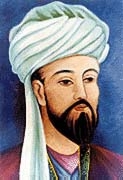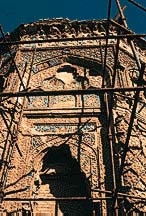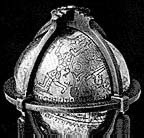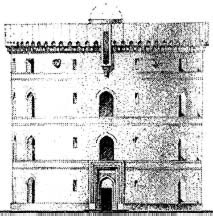|

Summer 1996 (4.2)
Page 35
Scientists Who
Made A Difference
Nasir
al-Din Tusi (1201-1274) and the Maragha Observatory
by Dr. Chingiz Qajar
  In 1253 AD, the
Mongols began their invasion in Persia and the Caucasus. As strange
as it may sound, for Nasir al-Din Tusi, it was a case of being
in the right place at the right time, although that place happened
to prison where he had been held captive for many years by the
Assassins, a religious terrorist group. The Mongolian occupation
led to his release. In 1253 AD, the
Mongols began their invasion in Persia and the Caucasus. As strange
as it may sound, for Nasir al-Din Tusi, it was a case of being
in the right place at the right time, although that place happened
to prison where he had been held captive for many years by the
Assassins, a religious terrorist group. The Mongolian occupation
led to his release.
In the end, it was, allegedly, Tusi who persuaded the Hulegu
Khan (Hulaku Khan) to continue his attack on Baghdad and destroy
the Abbasid Caliphate there. The Khan succeeded in 1258 and afterwards
made Tusi one of his personal advisers.
Hulegu then made Azerbaijan the center of his huge state which
was known as Mongolian Ilhanid Dynasty (in Azerbaijani, "People's
Khans"). Maragha, an ancient cultural center became the
first capital. Later on, it was changed to Tabriz.
Rationale for the
Observatory
It was then that Tusi,
being a scientist, persuaded the Khan to build an observatory
in Maragha. "And why do we need an observatory?" the
Khan reportedly asked Tusi, when he proposed such an expensive
undertaking. "Is the science about the stars so important
that we should spend such a great amount of money?"
 |
 |
Above:
Part of the Maragha Observatory
Complex that still stands today.
Then Tusi replied, "Allow me to carry out an experiment.
Let's arrange for someone secretly to go up this mountain and
cast down a large empty caldron." And so they did. When
the caldron came tumbling down, it produced such a terrible noise
that the Khan's soldiers panicked. Then Tusi remarked, "We
know the reason for all this clamor, that's why. And so it is,
if we know the secrets of the celestial phenomena, we will be
calm on the Earth." This incident was recorded by the well-known
historian, Haji Halifa, in his work, "A Book about the World."
The Khan agreed and allocated 2,000 dinars for the construction
of an Observatory which would be the largest in the East. Construction
began in 1259 and was carried out primarily by M Urdi and his
son, Mahmud.
  Left: A star globe from the Observatory
in Maragha made in 1279 and now preserved in Dresden, Germany.
It is a rare example decorative art from Azerbaijan of the 13th
century, designed by M. Ordi and made of bronze, inlaid with
silver and gold. Left: A star globe from the Observatory
in Maragha made in 1279 and now preserved in Dresden, Germany.
It is a rare example decorative art from Azerbaijan of the 13th
century, designed by M. Ordi and made of bronze, inlaid with
silver and gold.
The Observatory later provided
a model for a similar building in Peking. It was known to have
housed a an exceptionally large library and a school for training
specialists. Tusi gathered renowned scientists to be involved
with the construction of the instruments as well as actual observations.
Many other nationalities, in addition to Azerbaijanis, were involved
with the work including the Chinese astronomers, Georgians, Mongolians,
Turks, Persians, Arabs, Jews, and others.
Tusi, the Scholar
Tusi was a man of exceptionally broad knowledge. He was born
in 1201 in Tus in the Khorasan Province near the city of Mashad
(Persia at the time, now Iran). He became quite influential in
the East and wrote an enormous corpus of more than 100 works
in Arabic and Persian. Many of his works provide a well-consolidated
account of what others had previously accomplished. Many became
the standard in a number of disciplines up until modern times.
 Right: An architect's rendition of the
Maragha Observatory that was built in 1258 in Eastern Azerbaijan
Province in Iran. Right: An architect's rendition of the
Maragha Observatory that was built in 1258 in Eastern Azerbaijan
Province in Iran.
But Tusi also made substantial
contributions to knowledge himself. Most of the contemporary
researchers consider him first of all a mathematician. His works
played a great role in the development of geometry and trigonometry
not only in the East but also in Europe. It was Tusi who presented
trigonometry as an individual science for the first time in the
world. He also wrote on astronomy, physics, medicine, philosophy,
ethics, and logic.
He improved upon earlier Arabic translations of Avicenna (Canon
of Medicine), Euclid (Elements), Ptolemy (Almagest), Autolycus,
Theodosius, Apollonius and others.
About 20 works of his works make contributions to the fields
of mathematics and astronomy. The most famous is "The Astronomic
Tables of Ilhans" in four volumes which is a compilation
of the research carried out at the Maragha Observatory. His most
popular book dealt with ethics, "Ahlagi Nasiri."
Tusi died on June 25, 1274, in Baghdad. The calligraphic inscription
on his grave reads: "The helper of religion and people,
the Shah of the country of Science-such a son had never before
been born."
Today, the memory of Nasir al-Din Tusi is highly revered and
honored in the Republic of Azerbaijan. Many institutions have
been named after him including the National Pedagogical Institute
in Baku and the Observatory at Shemakha.
Dr. Chingiz Qajar, is a Member of Azerbaijan's Academy
of Sciences. His book, "Eminent Sons of Azerbaijan"
Biographical History Through the 19th Century" has just
been published by BP and Statoil Alliance. It includes 80 biographies
of outstanding scientists (including Tusi and Urdi), poets, artists,
calligraphers, musicians, statesmen, generals and theologians
in chronological order. In Russian.
From Azerbaijan International (4.2) Summer 1996
© Azerbaijan International 1996. All Rights Reserved.
Back to Index
AI 4.2 (Summer 1996)
AI Home
| Magazine
Choice
| Topics
| Store
| Contact
us
|





 Right: An architect's rendition of the
Maragha Observatory that was built in 1258 in Eastern Azerbaijan
Province in Iran.
Right: An architect's rendition of the
Maragha Observatory that was built in 1258 in Eastern Azerbaijan
Province in Iran.